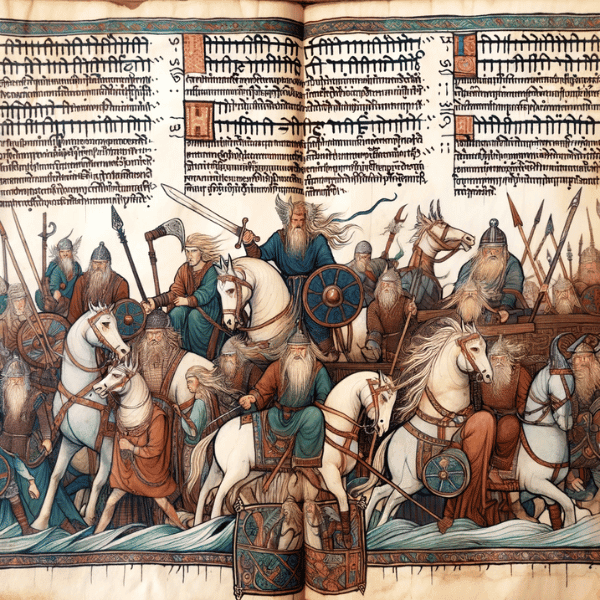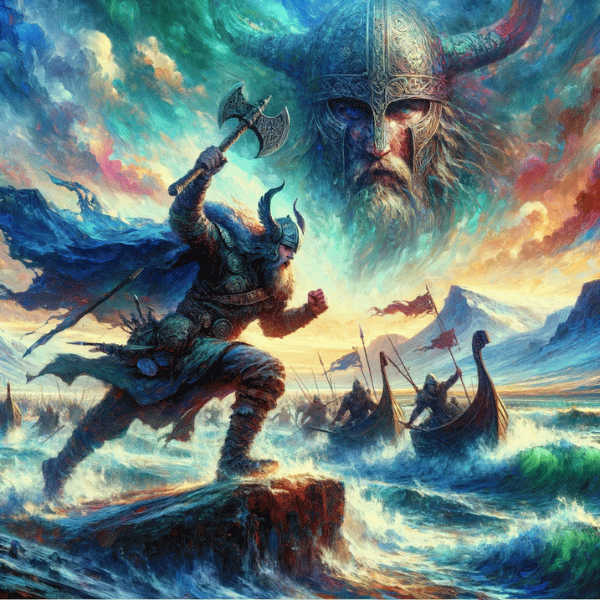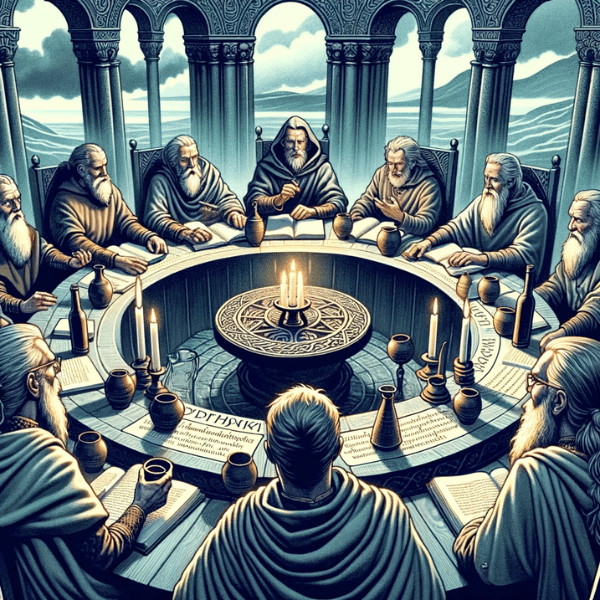Norse mythology, a cornerstone of ancient Scandinavian culture, stands as a rich tapestry of gods, heroes, and epic narratives that have profoundly influenced the cultural and historical landscape of Northern Europe. Among its many characters, Helgi Hundingsbane emerges as a figure of significant interest. He is not merely a character in these tales but a symbol of valor, tragedy, and the intricate web of fate central to Norse lore. In exploring the saga of Helgi Hundingsbane, we delve into a narrative that interweaves myth and legend, offering a window into the ancient Norse worldview and its enduring legacy. This article aims to illuminate Helgi’s pivotal role in Norse mythology, unraveling his story to reveal the deeper themes and cultural significance embedded within his legendary exploits.
| Attribute | Helgi Hundingsbane Information |
|---|---|
| Origin | Norse Mythology and Norse Sagas |
| Heroic Figure | Legendary hero known for his valor and heroic deeds |
| Nemesis | Famed for his conflicts with the Hunding clan, particularly Hunding himself |
| Love Story | Associated with a tragic love story involving Sváva (Sigrún) |
| Sword | Wielded the sword Gram, a renowned weapon |
| Cultural Impact | A central figure in Norse sagas and heroic poetry, symbolizing heroism and honor |
| Depictions | Featured prominently in various Norse sagas and poems, known for his heroic exploits |
1. The Legend of Helgi Hundingsbane
Historical Context
Helgi Hundingsbane, an emblematic hero of Norse mythology, is deeply rooted in the ancient poetic and prose traditions of Scandinavia. Two significant sources primarily chronicle his tales: the Poetic Edda, a collection of anonymous Old Norse poems from the Viking Age, and the later prose work, the Völsunga Saga. In the Poetic Edda, two lays, “Helgakviða Hundingsbana I” and “Helgakviða Hundingsbana II,” immortalize Helgi’s exploits. These texts not only narrate his heroic deeds but also encapsulate the ethos and values of the Norse world, blending historical elements with mythic grandeur.
The Story of Helgi
Helgi Hundingsbane’s story is a tapestry of heroism, vengeance, and fate. Born as a prince, Helgi is the son of Sigmund, a renowned warrior in Norse lore, and his wife Borghild. His tale is marked by a prophecy that foretells his destiny to become a great warrior. Helgi’s life is defined by his quest for vengeance against King Hunding, an enemy of his family, earning him the epithet “Hundingsbane,” meaning slayer of Hunding.

In his youth, Helgi avenges his father’s death by killing Hunding, showcasing his prowess as a warrior. His battles are not just mere conflicts; they are imbued with symbolic significance, often reflecting the struggle between order and chaos, a recurring theme in Norse mythology. One of his notable achievements includes the leadership of a band of warriors, with whom he undertakes numerous heroic feats.
Helgi’s story is also marked by his tragic love affair with Sigrún, a valkyrie. Their love, hindered by familial feuds and obligations, adds a layer of romantic tragedy to his legend. The saga culminates in Helgi’s eventual death, which is not merely an end but a transition to a different existence, as per Norse beliefs about the afterlife and rebirth.
2. Analysis of Helgi’s Character
Helgi as a Hero
In the pantheon of Norse mythology, Helgi Hundingsbane stands out as a quintessential hero, embodying characteristics revered in Norse culture. His bravery and skill in battle are paramount, aligning with the Norse valorization of warrior virtues. Unlike mere fighters, Helgi demonstrates a blend of courage, strategic intellect, and a sense of justice, particularly in avenging his father’s death and battling against familial foes. This pursuit of honor through vengeance is a recurring theme in Norse heroism, drawing parallels with other legendary figures like Sigurd from the Völsunga Saga. However, Helgi’s heroism is also nuanced with his capacity for love and deep emotional connections, as seen in his relationship with Sigrún. This multifaceted nature sets him apart from more one-dimensional warriors, illustrating the complexity of heroism in Norse tales.

Symbolism and Themes
Helgi Hundingsbane’s saga is rich with symbolism and thematic depth that resonate with broader Norse beliefs and values. His story transcends the mere chronicle of a warrior’s life, embodying themes of fate, love, and the cyclical nature of existence. The Norse concept of ‘wyrd’ or fate plays a pivotal role in Helgi’s life, indicating the inevitable path that heroes must tread. This interplay between destiny and personal agency reflects the Norse understanding of a preordained yet interactive universe.
Furthermore, Helgi’s relationships, especially with Sigrún, are emblematic of the intertwining of love and duty, a common motif in Norse narratives. Their tragic love story transcends the personal, touching upon the theme of sacrifice for higher obligations. This resonates with the Norse value of loyalty to one’s clan and duty over personal desires.
Additionally, Helgi’s death and implied rebirth, as suggested in some interpretations of the saga, align with the Norse belief in the cyclical nature of life and the afterlife. This notion challenges the finality of death, presenting it as a transition to another form of existence, a concept deeply ingrained in Norse spirituality.
3. Helgi Hundingsbane in Norse Culture
Cultural Impact
The legacy of Helgi Hundingsbane extends far beyond the ancient manuscripts that first recorded his saga. His story has been a significant cultural influence, echoing through centuries of Norse folklore and beyond. In the realms of literature and art, Helgi’s tale has inspired countless retellings and adaptations, each resonating with the heroic ethos of the Norse world. His character has been a muse for poets, writers, and artists, who have found in his saga a rich source of heroism, conflict, and drama.
In modern times, the influence of Helgi Hundingsbane permeates popular culture, visible in genres ranging from fantasy literature to video games. Elements of his story can be seen in contemporary narratives that feature themes of heroism, vengeance, and star-crossed love. The fascination with Norse mythology in popular media often brings Helgi’s character, either in essence or direct reference, to a new audience, illustrating the timeless appeal of these ancient sagas.

Lessons and Morals
The story of Helgi Hundingsbane, while rooted in a distant mythological past, imparts lessons and morals that hold relevance even in contemporary society. One of the most profound lessons is the exploration of the hero’s journey, not just as a path of glory but also as a journey fraught with personal sacrifice and ethical dilemmas. Helgi’s life encourages reflection on the balance between personal desires and societal duties, a dilemma that resonates across ages.
Additionally, his saga highlights the concept of fate and how it intertwines with personal choice. The Norse belief in a preordained destiny, yet allowing room for individual agency, offers a perspective on how one navigates life’s challenges and choices.
Moreover, Helgi’s story, with its themes of love, loyalty, and vengeance, prompts a contemplation on the complexity of human emotions and relationships. The tragic elements of his love story with Sigrún, in particular, speak to the enduring nature of love and the sacrifices it often entails.
4. Academic Perspectives
Scholarly Interpretations
The legend of Helgi Hundingsbane has been a subject of considerable interest in academic circles, with scholars offering various interpretations of his story. A common thread in scholarly discourse is the examination of Helgi as a quintessential Norse hero whose narrative encapsulates key elements of Norse mythological and cultural values. Researchers often point to Helgi’s saga as a reflection of the warrior ethos prevalent in Viking society, emphasizing themes of honor, vengeance, and fate. For instance, in Jan de Vries’ seminal work on Norse mythology, Helgi’s character is analyzed in the context of Germanic heroism and its societal implications.
Another focal point of academic inquiry is the exploration of the saga’s poetic structure and literary devices, as highlighted in the works of scholars like Margaret Clunies Ross. The oral tradition and its transition into written form, as seen in the Eddas and sagas, is a topic of significant interest, shedding light on the evolution of Norse literary culture.

Debates and Controversies
Despite the extensive research on Helgi Hundingsbane, his legend is not without its debates and controversies. One area of scholarly debate revolves around the historical authenticity of Helgi’s character. Some researchers argue that Helgi may have been based on a real historical figure, while others contend that he is purely a product of myth and legend.
Another contentious topic is the interpretation of the supernatural elements in Helgi’s story, particularly his interactions with valkyries and the concept of rebirth. Scholars are divided on whether these elements should be understood literally, as reflections of Norse spiritual beliefs, or metaphorically, as poetic devices to enhance the narrative.
Additionally, the variations in Helgi’s story across different texts, such as the Poetic Edda and Völsunga Saga, have sparked discussions about the transmission and adaptation of myths over time. This has led to broader questions about authorship, audience, and the purpose of myth-making in Norse society.
5. Conclusion
In exploring the saga of Helgi Hundingsbane, we journeyed through the historical origins of his legend, delving into the depths of Norse literature. We witnessed his portrayal as a hero embodying the virtues and complexities of Norse mythology, and analyzed the thematic richness of his story, from themes of fate and love to the interplay of duty and personal desire. We also observed his enduring impact on Norse culture and modern media, and the valuable lessons his tale imparts for contemporary life. Scholarly interpretations and debates further enriched our understanding of his narrative’s significance. Helgi Hundingsbane’s saga, a blend of mythic grandeur and human struggle, prompts us to reflect: How do the legends of the past continue to shape our understanding of heroism, morality, and our own life journeys?
